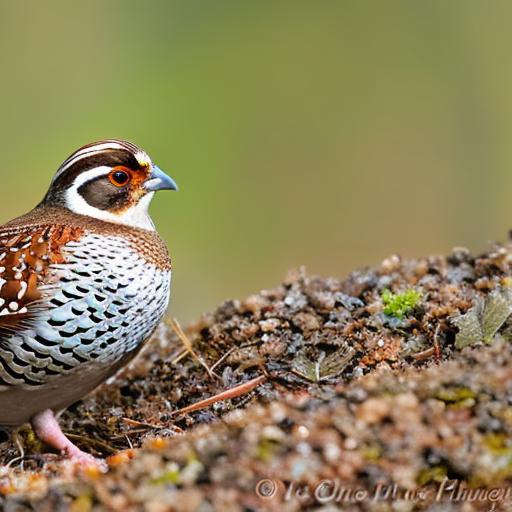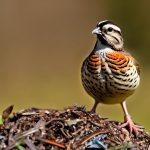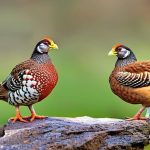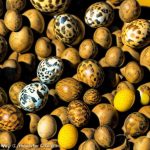Quails are small, ground-dwelling birds that belong to the family Phasianidae. There are many species of quail, but two of the most popular for domestication are the Bobwhite quail (Colinus virginianus) and the Coturnix quail (Coturnix japonica). Bobwhite quail are native to North America and are known for their distinctive “bob-white” call, which gives them their name. They are popular game birds and are often raised for hunting purposes. Coturnix quail, on the other hand, are native to Asia and Europe and are smaller in size compared to Bobwhite quail. They are often raised for their eggs and meat and are known for their fast growth and high egg production.
Both Bobwhite and Coturnix quail are popular choices for backyard poultry enthusiasts due to their small size, low maintenance requirements, and relatively quiet nature. They are also well-suited for small spaces, making them an ideal choice for urban or suburban settings. Additionally, quail eggs are considered a delicacy in many cultures and are known for their rich flavor and high nutritional value. Overall, quails are fascinating birds with a rich history of domestication and provide a variety of benefits to those who choose to raise them.
Key Takeaways
- Bobwhite and Coturnix quail are popular game birds and are also kept for their eggs and meat.
- Quail thrive in open grasslands, agricultural fields, and brushy areas with access to water.
- Quail require a diet high in protein, such as insects, seeds, and vegetation, and may benefit from supplemental feed.
- Quail breeding and reproduction can be influenced by factors such as photoperiod and temperature.
- Common health issues for quail include respiratory infections and parasites, and proper care involves providing a clean environment and regular monitoring.
Habitat and Environment for Quail
Quails are adaptable birds that can thrive in a variety of habitats, including grasslands, woodlands, and agricultural areas. When it comes to raising quail in a domestic setting, it’s important to provide them with a suitable environment that mimics their natural habitat. This includes a spacious outdoor area with access to grass, shrubs, and other vegetation for foraging. Additionally, quails require shelter from the elements and protection from predators, so providing them with a secure coop or aviary is essential.
For Bobwhite quail, it’s important to create an environment that resembles their native grassland habitat. This can be achieved by providing a mix of grassy areas, shrubs, and open spaces within their enclosure. Coturnix quail, on the other hand, prefer a more densely vegetated environment with plenty of cover and hiding spots. Both species of quail require access to clean water for drinking and bathing, so providing a shallow dish or waterer is essential for their well-being.
Overall, creating a suitable habitat for quail involves providing them with ample space to roam and forage, as well as shelter and protection from the elements and predators. By mimicking their natural environment as closely as possible, quails can thrive and exhibit natural behaviors in a domestic setting.
Feeding and Nutrition for Quail
Proper nutrition is essential for the health and well-being of quail. In the wild, quails are omnivorous birds that feed on a variety of seeds, insects, and vegetation. When raising quail in a domestic setting, it’s important to provide them with a balanced diet that meets their nutritional needs. This can be achieved by offering a commercial game bird feed that is specifically formulated for quails. These feeds typically contain a mix of grains, seeds, and protein sources to support the dietary requirements of quail.
In addition to commercial feed, quails can also benefit from supplemental treats such as mealworms, fruits, and vegetables. These treats can provide additional nutrients and enrichment for quails, but should be offered in moderation to prevent nutritional imbalances. It’s also important to provide access to grit or small stones, which quails use to aid in the digestion of their food.
Water is another essential component of a quail’s diet, as it is necessary for digestion, temperature regulation, and overall health. Clean, fresh water should be provided at all times, either through a shallow dish or waterer that is easily accessible to the quails.
Overall, providing a balanced diet that meets the nutritional needs of quail is essential for their health and well-being. By offering a combination of commercial feed, supplemental treats, and access to clean water, quails can thrive in a domestic setting.
Breeding and Reproduction of Quail
Breeding quail can be a rewarding experience for poultry enthusiasts, as these birds are prolific layers and can reproduce at a relatively young age. When it comes to breeding quail, there are several factors to consider in order to ensure successful reproduction. One of the most important considerations is providing the quails with a suitable breeding environment. This includes a spacious nesting area with plenty of nesting material such as straw or hay. Quails also require privacy and seclusion during the breeding process, so providing them with nesting boxes or secluded areas within their enclosure is essential.
In terms of breeding behavior, male quails will often perform elaborate courtship displays to attract females. Once a pair has formed, the female will lay eggs in the nesting area over a period of several days. Quails are known for their high egg production, with Coturnix quail laying up to 300 eggs per year and Bobwhite quail laying around 100 eggs per year. After the eggs are laid, they require an incubation period of approximately 17-18 days before hatching.
For those interested in hatching quail eggs, investing in an incubator can be a worthwhile endeavor. Incubators provide a controlled environment for the eggs to develop and hatch, ensuring a higher success rate compared to natural incubation. Once the eggs have hatched, the chicks will require proper care and nutrition to ensure their health and well-being.
Overall, breeding quail requires careful consideration of their breeding environment, behavior, and nutritional needs. By providing them with suitable nesting areas, privacy during the breeding process, and proper care for the eggs and chicks, poultry enthusiasts can successfully breed quail in a domestic setting.
Common Health Issues and Care for Quail
Like all animals, quails are susceptible to a variety of health issues that can impact their well-being. It’s important for poultry enthusiasts to be aware of common health problems that may affect quails and take proactive measures to prevent illness and promote good health. One common health issue in quails is respiratory infections, which can be caused by poor ventilation, high humidity, or exposure to drafts. To prevent respiratory issues, it’s important to provide quails with a well-ventilated coop or aviary that is free from drafts and excessive moisture.
Another common health concern for quails is parasites such as mites and lice. These external parasites can cause irritation and discomfort for quails, leading to decreased egg production and overall health issues. Regular inspections of the birds and their living environment can help identify and address parasite infestations before they become a serious problem.
In addition to respiratory infections and parasites, quails can also suffer from nutritional deficiencies if they are not provided with a balanced diet. It’s important to offer a commercial game bird feed that meets the nutritional needs of quails, as well as supplemental treats such as mealworms and fresh fruits and vegetables. Providing access to clean water at all times is also essential for preventing dehydration and maintaining overall health.
Overall, proactive measures such as providing a suitable living environment, regular health checks, and a balanced diet can help prevent common health issues in quails. By staying vigilant and addressing any potential health concerns promptly, poultry enthusiasts can ensure the well-being of their quail flock.
Predators and Protection for Quail
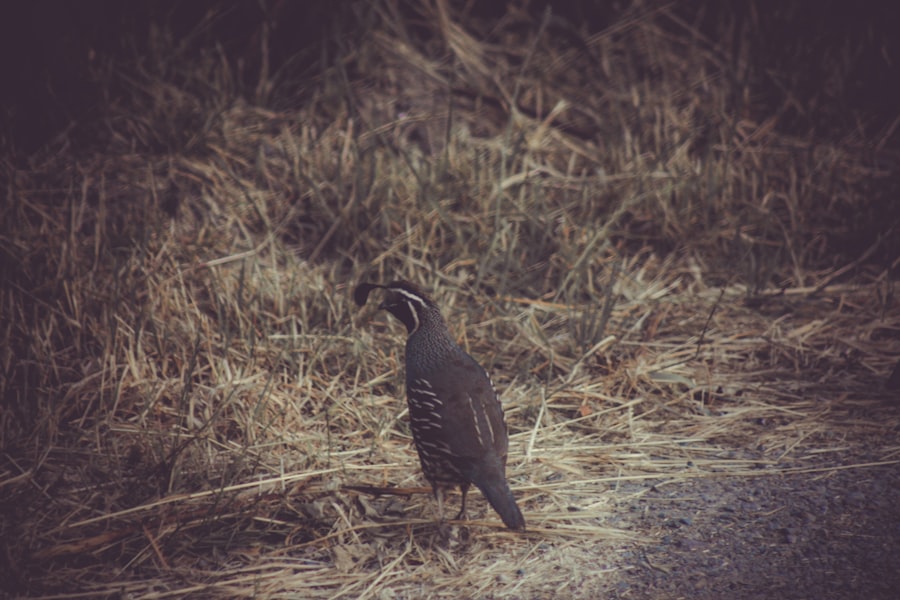
Quails are prey animals that are vulnerable to predation from a variety of predators including hawks, owls, foxes, raccoons, snakes, and domestic pets such as cats and dogs. In order to protect quails from predators, it’s important to take proactive measures to secure their living environment and minimize the risk of predation. This can be achieved by providing them with a secure coop or aviary that is predator-proof and offers protection from aerial predators as well as ground-based threats.
When designing a predator-proof enclosure for quails, it’s important to use sturdy materials such as hardware cloth or welded wire to prevent predators from gaining access. Additionally, adding a secure roof or cover to the enclosure can help protect quails from aerial predators such as hawks and owls. It’s also important to consider the surrounding landscape when housing quails, as providing them with ample cover such as shrubs or dense vegetation can offer additional protection from predators.
In addition to securing their living environment, it’s important to be mindful of potential threats from domestic pets such as cats and dogs. Keeping quails in a fenced area or supervised free-range setting can help minimize the risk of predation from household pets.
Overall, protecting quails from predators requires careful consideration of their living environment and potential threats from both wild predators and domestic pets. By taking proactive measures to secure their enclosure and minimize the risk of predation, poultry enthusiasts can help ensure the safety and well-being of their quail flock.
Benefits and Considerations of Keeping Quail
Raising quail can offer a variety of benefits for poultry enthusiasts, including their small size, low maintenance requirements, high egg production (in the case of Coturnix quail), and rich flavor of their eggs. Quails are well-suited for small spaces such as urban or suburban backyards due to their compact size and relatively quiet nature. Additionally, they are prolific layers that can provide a consistent supply of eggs throughout the year.
Quails also have relatively low maintenance requirements compared to other poultry species such as chickens or ducks. They require less space, food, and water compared to larger birds, making them an ideal choice for those with limited resources or space constraints. Additionally, quails reach maturity at a relatively young age and can begin laying eggs as early as 6-8 weeks old.
While there are many benefits to keeping quail, there are also several considerations that poultry enthusiasts should keep in mind before embarking on raising these birds. Quails have specific housing and environmental requirements that need to be met in order for them to thrive in a domestic setting. Additionally, they require access to clean water at all times and a balanced diet that meets their nutritional needs.
Overall, keeping quail can be a rewarding experience for poultry enthusiasts due to their small size, low maintenance requirements, high egg production (in the case of Coturnix quail), and rich flavor of their eggs. By carefully considering their housing and environmental needs as well as providing them with proper nutrition and care, poultry enthusiasts can successfully raise healthy and productive quail in a domestic setting.
Overall, keeping quail can be a rewarding experience for poultry enthusiasts due to their small size, low maintenance requirements, high egg production (in the case of Coturnix quail), and rich flavor of their eggs. By carefully considering their housing and environmental needs as well as providing them with proper nutrition and care, poultry enthusiasts can successfully raise healthy and productive quail in a domestic setting. Additionally, quail are known for their gentle nature and can be a great option for those with limited space or zoning restrictions. With the right knowledge and dedication, raising quail can be a fulfilling hobby that provides a sustainable source of fresh eggs for the household.
If you’re interested in raising quail, you may also want to check out this informative article on PoultryWizard about the best practices for keeping bobwhite and coturnix quail. It provides valuable insights into creating a suitable environment for these birds and ensuring their well-being. You can find the article here.
FAQs
What are bobwhite and coturnix quail?
Bobwhite and coturnix quail are two species of small game birds that are commonly raised for meat and eggs. They are popular among hunters and backyard poultry enthusiasts for their delicious meat and easy care.
What are the differences between bobwhite and coturnix quail?
Bobwhite quail are native to North America and are known for their distinctive call and behavior. They are typically larger and have a more pronounced crest on their head. Coturnix quail, on the other hand, are native to Asia and Europe and are known for their rapid growth and high egg production. They are smaller in size and have a more subdued appearance compared to bobwhite quail.
How are bobwhite and coturnix quail raised?
Both bobwhite and coturnix quail can be raised in captivity in a variety of housing systems, including cages, pens, or aviaries. They require a balanced diet of commercial quail feed, supplemented with fresh greens and insects. Proper housing, temperature control, and predator protection are essential for their well-being.
What are the benefits of raising bobwhite and coturnix quail?
Raising bobwhite and coturnix quail can provide a sustainable source of meat and eggs for personal consumption or sale. They are relatively low-maintenance and can be raised in small spaces, making them an ideal choice for backyard poultry enthusiasts. Additionally, they are known for their delicious, lean meat and nutritious eggs.
Are there any legal considerations for raising bobwhite and coturnix quail?
It is important to check local regulations and obtain any necessary permits or licenses before raising bobwhite and coturnix quail. In some areas, there may be restrictions on the number of birds that can be kept, as well as specific requirements for housing and care. It is important to research and comply with all relevant laws and regulations.
Meet Walter, the feathered-friend fanatic of Florida! Nestled in the sunshine state, Walter struts through life with his feathered companions, clucking his way to happiness. With a coop that’s fancier than a five-star hotel, he’s the Don Juan of the chicken world. When he’s not teaching his hens to do the cha-cha, you’ll find him in a heated debate with his prized rooster, Sir Clucks-a-Lot. Walter’s poultry passion is no yolk; he’s the sunny-side-up guy you never knew you needed in your flock of friends!

